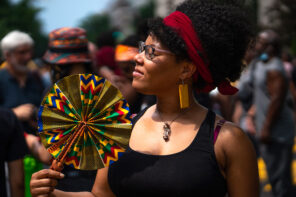When the Discovery Institute’s Wedge Document was written in the late 1990s, its purpose was “affirm the reality of God” and to “renew” American culture by shaping public policy to reflect conservative Christian values.
At the time, the pro-intelligent design organization was using the fundraising document to raise money to “defeat scientific materialism” represented by evolution, and “reverse the stifling materialist world view and replace it with a science consonant with Christian and theistic convictions.”
But now, it looks like the strategy has been expanded to fight a culture war over the interpretation of our nation’s history.
Even though the Discovery Institute hasn’t been involved in the social studies boondoggle that has been taking place in Texas, the Board of Education has been following the Wedge Document blueprint as it rewrites its textbook guidelines.
The story in the New York Times Magazine on Sunday by Russell Shorto brilliantly laid out the history of members of TBOE and their attempt to hijack the education of America’s children with religious doctrine.
It’s a must read for anyone who wants to understand the motivations of the Christian Right regarding the long-term goals for our education system, playing out now in Texas. As board member Cynthia Dunbar, who opposes public education, has said, “the philosophy of the classroom in one generation will become the philosophy of the government in the next.”
But what I found most fascinating about the piece is the explanation behind the religious right’s recent interest in the Declaration of Independence. Christian activists like David Barton (who served as a curriculum advisor to the TBOE) have been campaigning to shift the focus from the Constitution in civics class to the Declaration of Independence. (In another arena, today’s Mount Vernon Statement, released by conservative and religious right figures, maintains “we need a restatement of Constitutional conservatism grounded in the priceless principle of ordered liberty articulated in the Declaration of Independence and the Constitution.”)
The reason is pretty clear. The Declaration refers to a “creator,” while the Constitution contains no mention of God. So they intend to use the Declaration to further the argument that the founding fathers wanted to create a “Christian nation” even though they forgot to mention that concept in the one document that outlines the code by which this nation would be governed.
In the article, Dunbar outlines a proposed legal strategy to defend linking the two documents:
Dunbar began the lecture by discussing a national day of thanksgiving that Gen. George Washington called for after the defeat of the British at Saratoga in 1777—showing, in her reckoning, a religious base in the thinking of the country’s founders. In developing a line of legal reasoning that the future lawyers in her class might use, she wove her way to two Supreme Court cases in the 1960s, in both of which the court ruled that prayer in public schools was unconstitutional. A student questioned the relevance of the 1777 event to the court rulings, because in 1777 the country did not yet have a Constitution. “And what did we have at that time?” Dunbar asked. Answer: “The Declaration of Independence.” She then discussed a legal practice called “incorporation by reference.” “When you have in one legal document reference to another, it pulls them together, so that they can’t be viewed as separate and distinct,” she said. “So you cannot read the Constitution distinct from the Declaration.” And the Declaration famously refers to a Creator and grounds itself in “the Laws of Nature and of Nature’s God.” Therefore, she said, the religiosity of the founders is not only established and rooted in a foundational document but linked to the Constitution. From there she moved to “judicial construction and how you should go forward with that,” i.e., how these soon-to-be lawyers might work to overturn rulings like that against prayer in schools by using the founding documents.
For anyone who values freedom to worship according to one’s conscience, this is scary stuff. If you haven’t read the article yet, I encourage you to read all of it. Those who have read the Wedge Document will recognize the sound of it in Shorto’s account of the Texas battle.
The Christian “truth” about America’s founding has long been taught in Christian schools, but not beyond. Recently, however—perhaps out of ire at what they see as an aggressive, secular, liberal agenda in Washington and perhaps also because they sense an opening in the battle, a sudden weakness in the lines of the secularists—some activists decided that the time was right to try to reshape the history that children in public schools study. Succeeding at this would help them toward their ultimate goal of reshaping American society.




